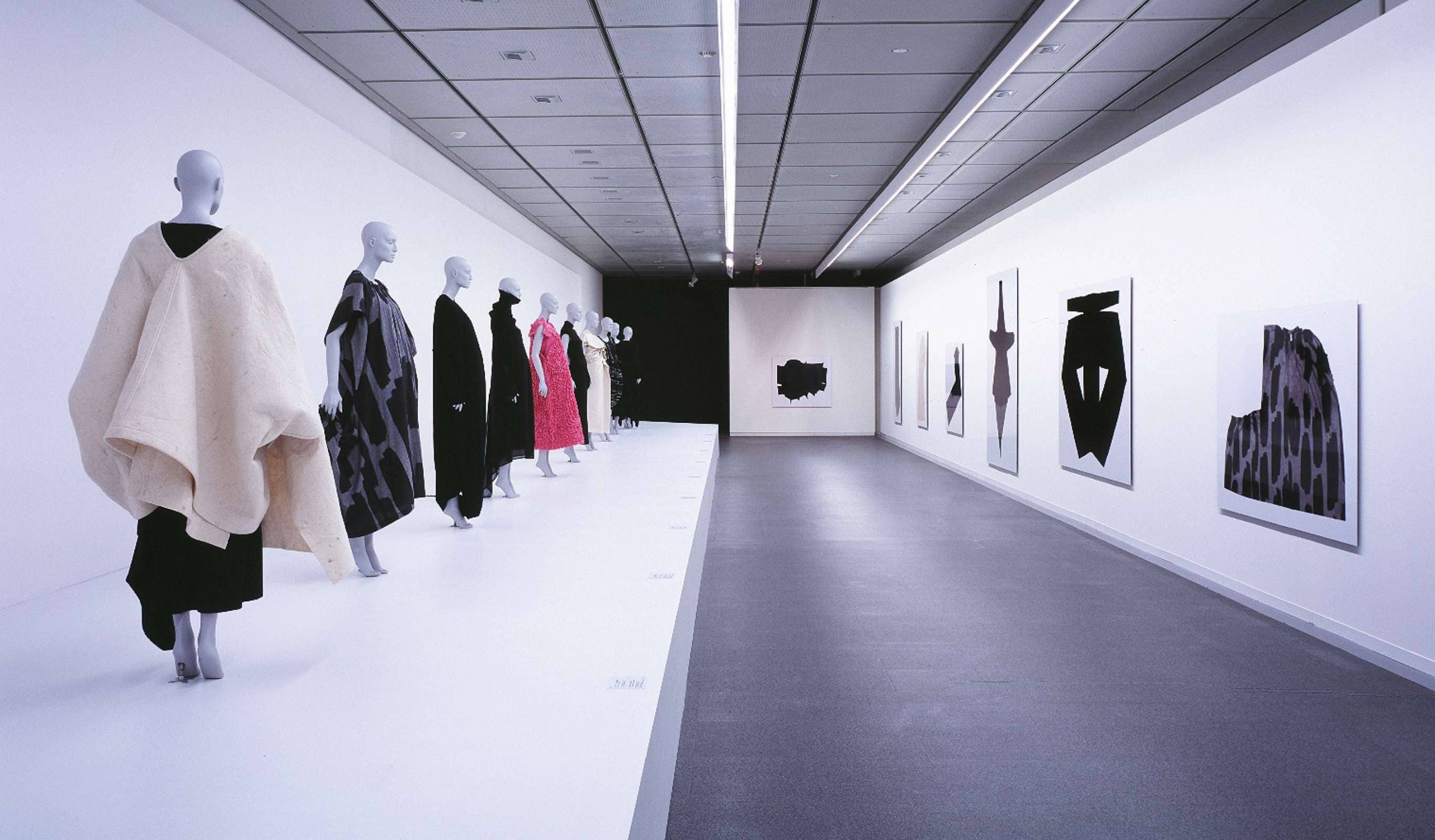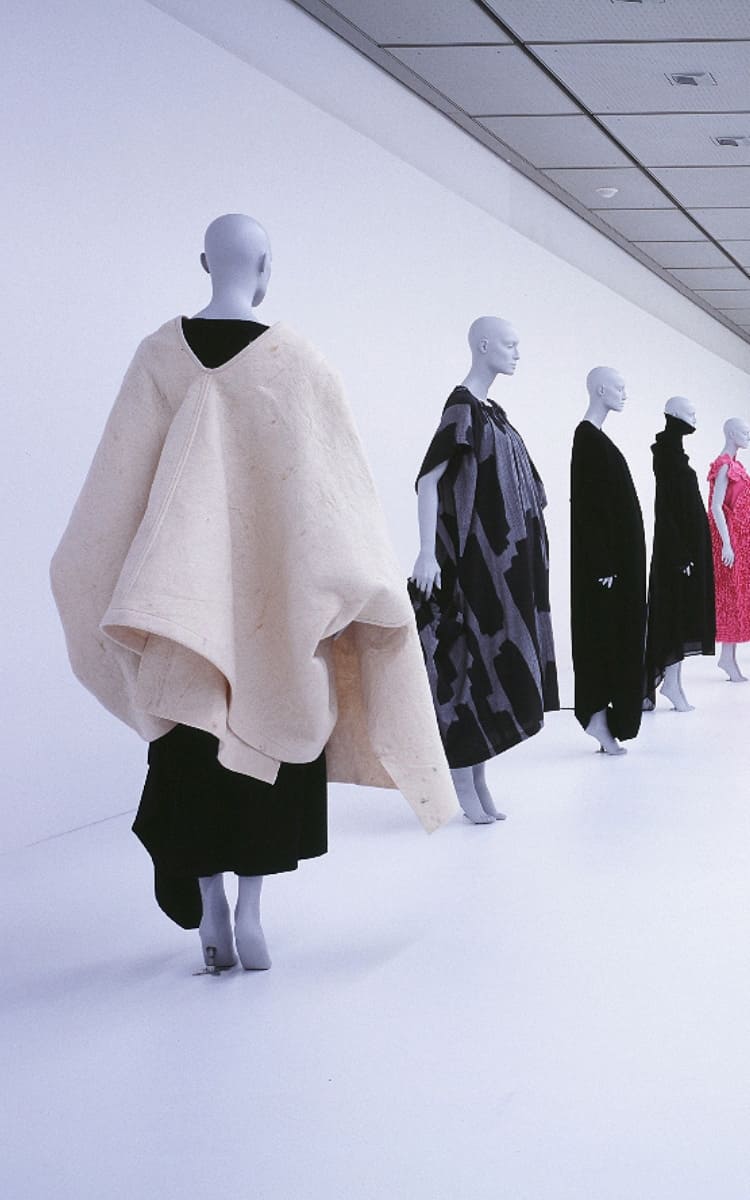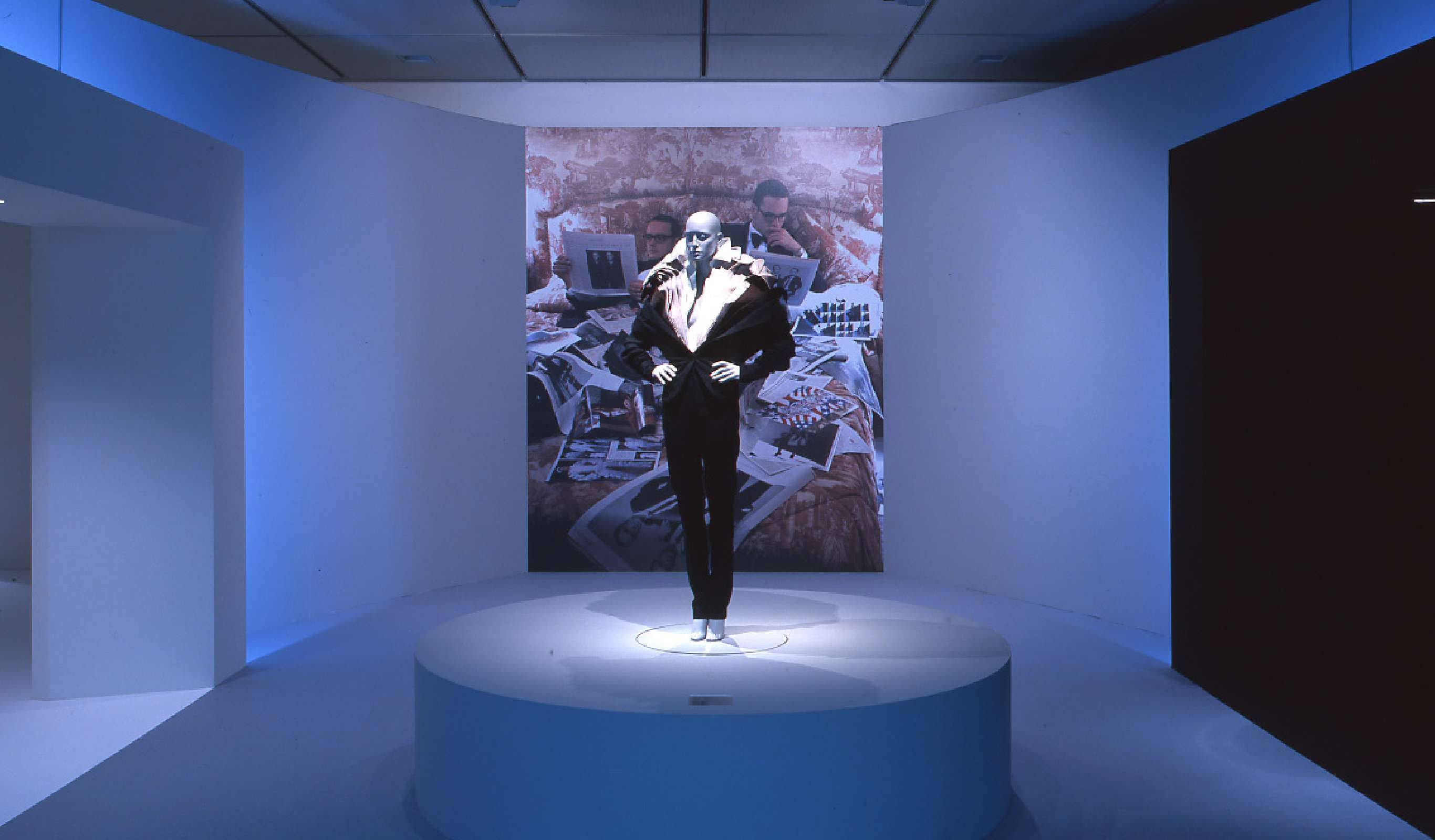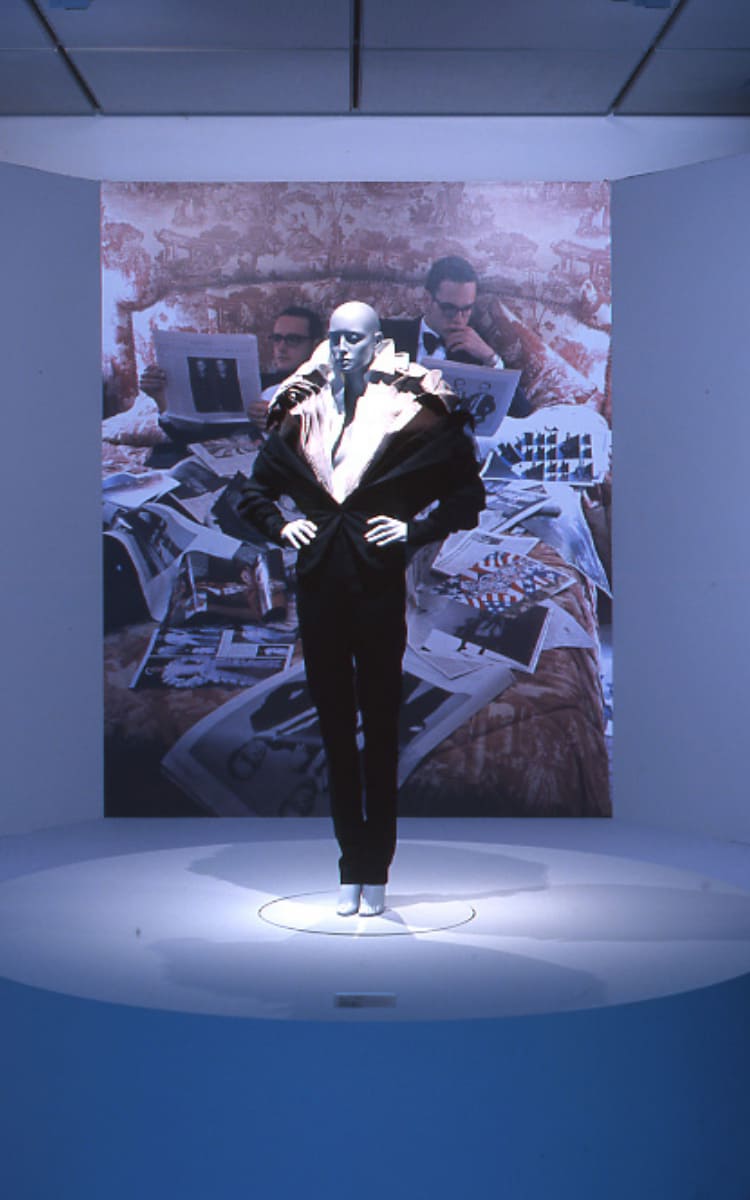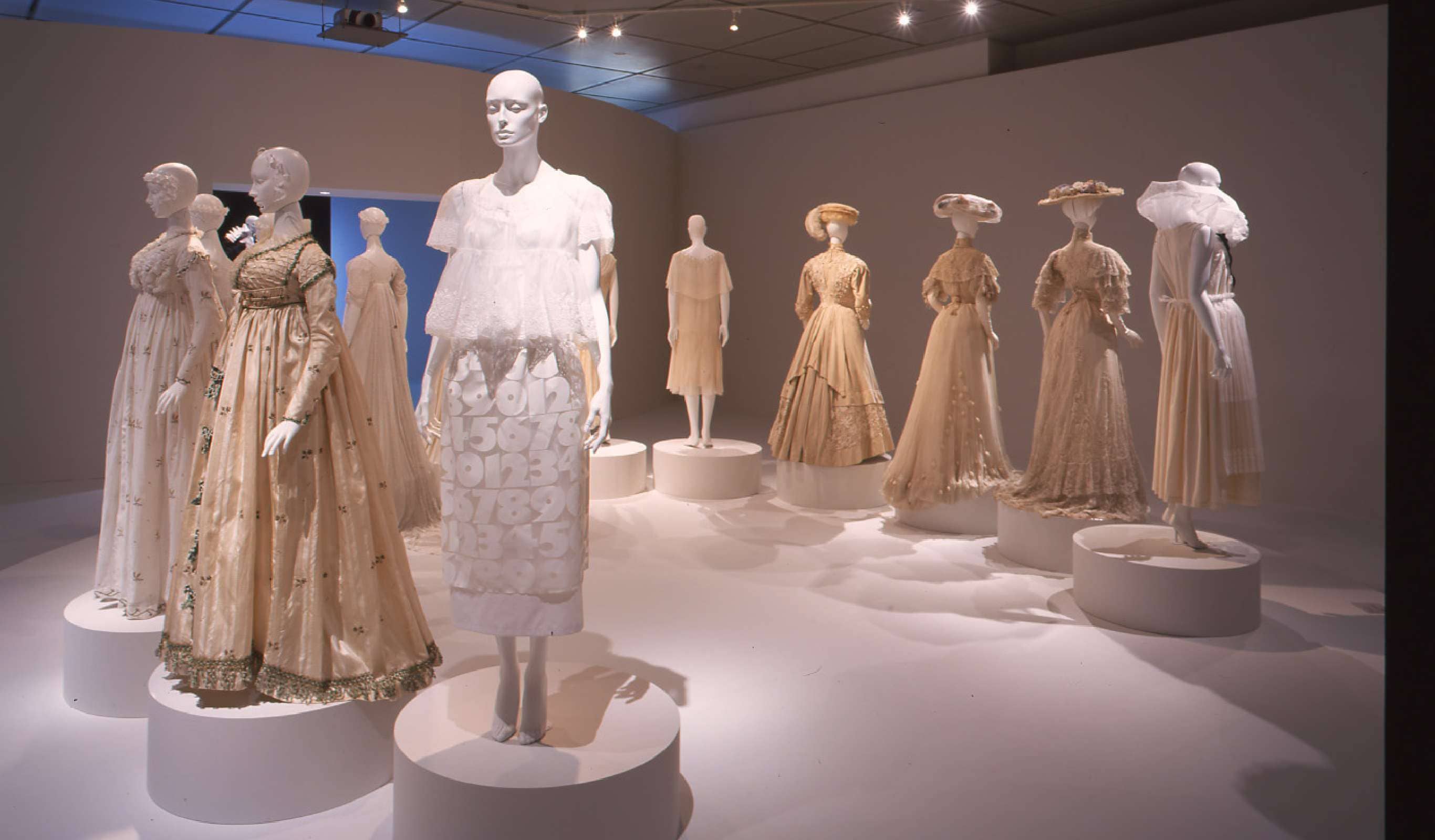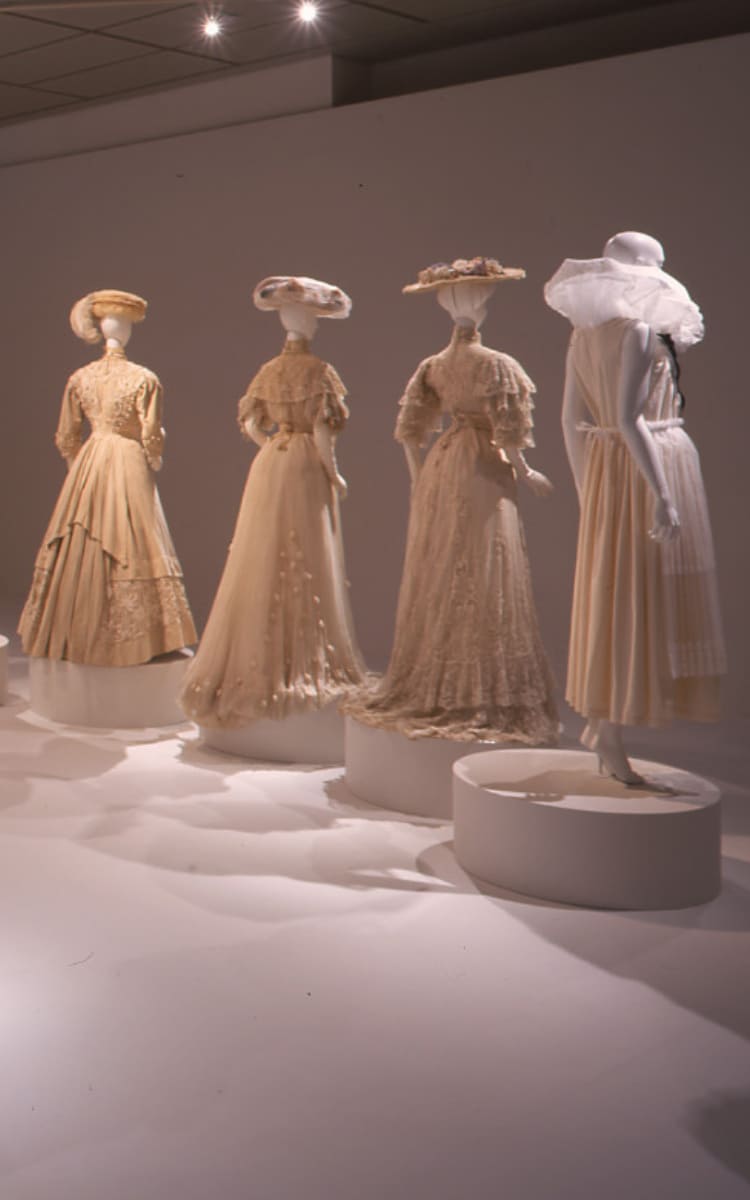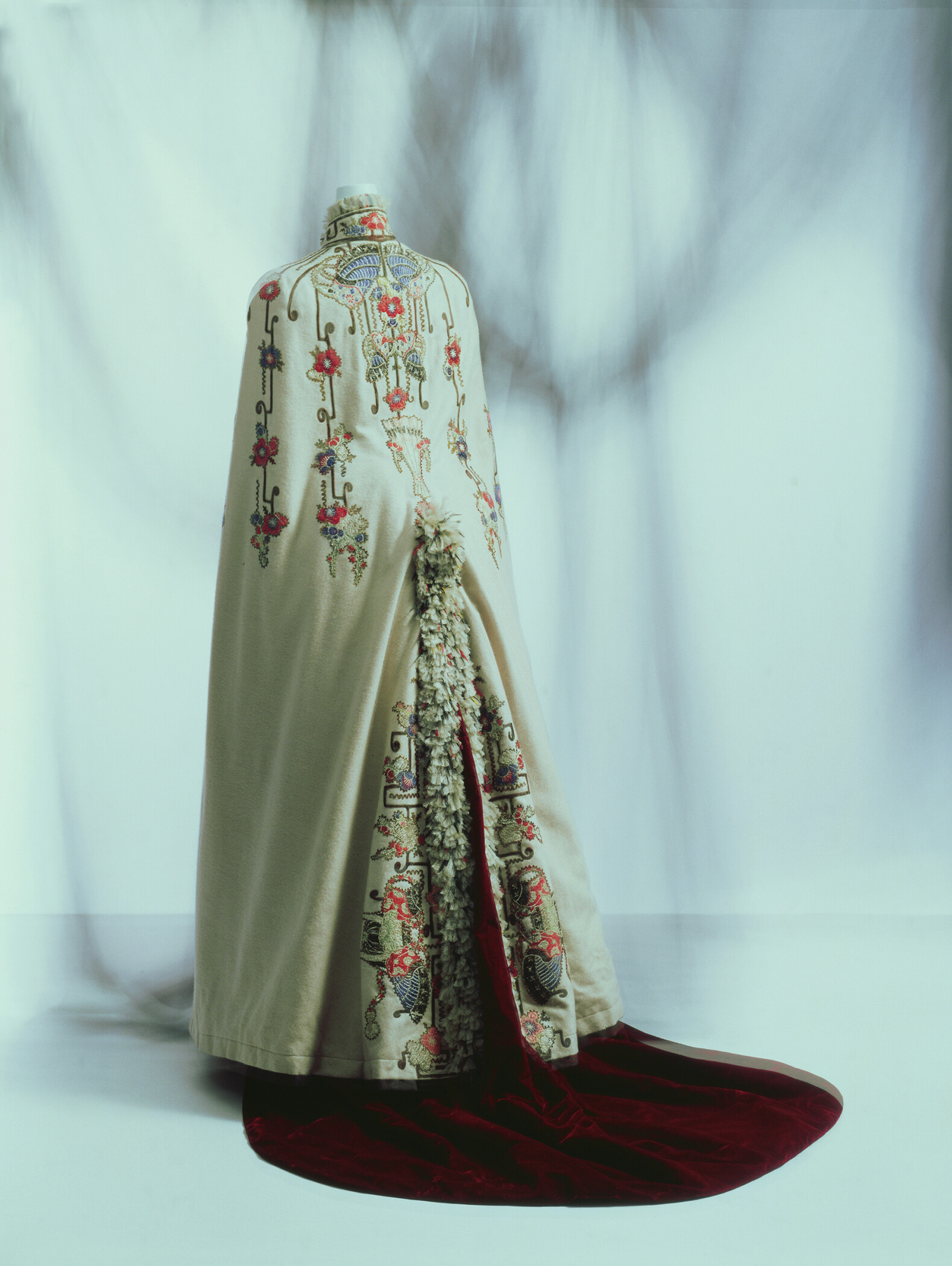 © ©The Kyoto Costume Institute, photo by Richard Haughton
© ©The Kyoto Costume Institute, photo by Richard Haughton
Visitec. 1890 - France
This gorgeous piece is a fascinating example of Japanese designs referenced by Paris fashion. Japanese motifs of cherry blossoms and kabuto (samurai helmets) are arranged vertically. These motifs were hand-worked in elaborate cord embroidery onto separate silk cloths, which was then applied to the cashmere. The sideways-oriented kabuto that acts as a counterpart to the cherry blo
ssoms is laid out symmetrically in a European fashion. The visite is one version of a coat created for the bustle silhouette.Material
Off-white cashmere twill; appliqués of embroidered fabrics with kabuto (samurai helmet), butterfly and cherry blossom motifs; feathers at front, collar and back slit.
Inventory Number(s)
AC5367 86-17-7
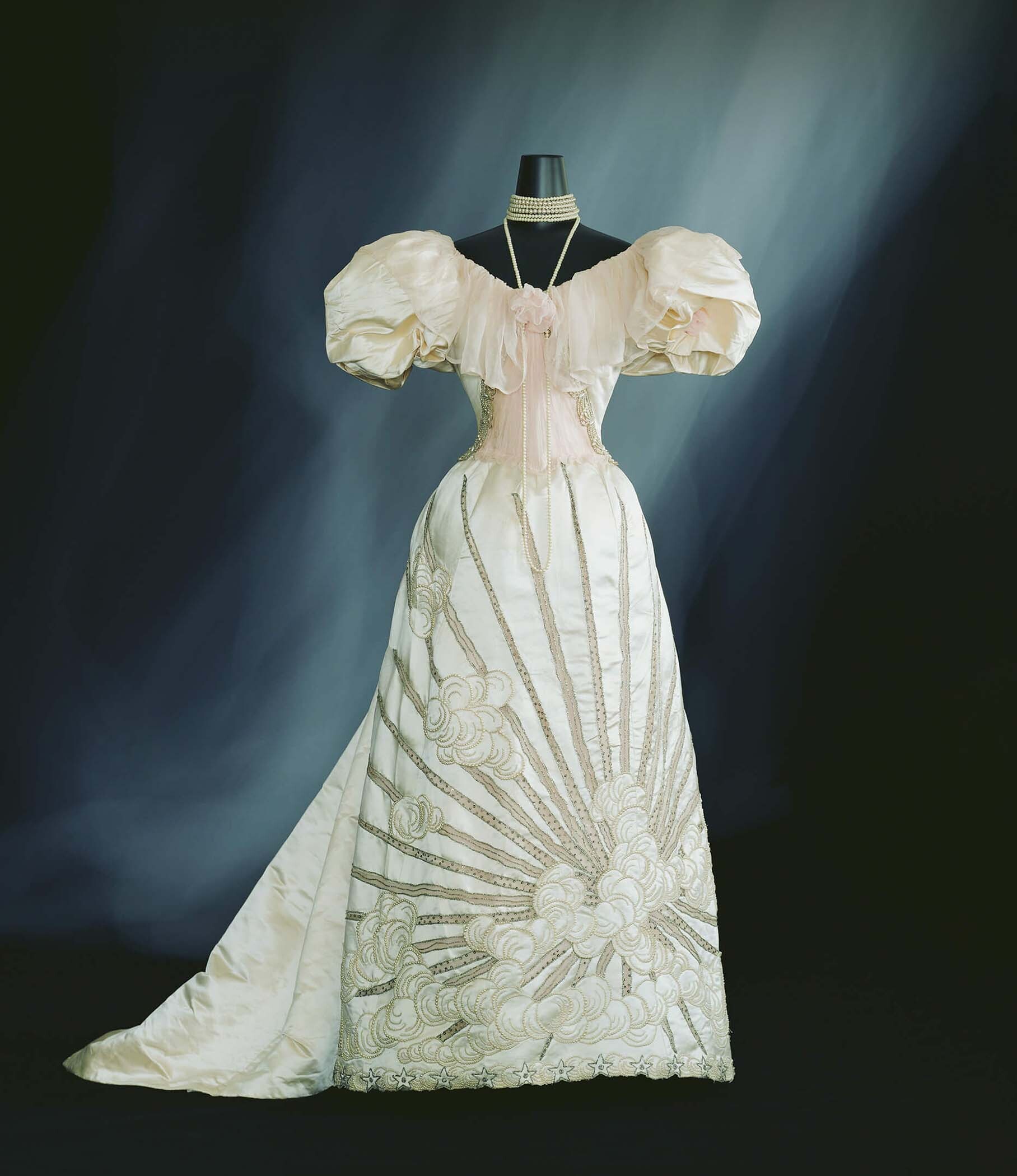 © The Kyoto Costume Institute, photo by Richard Haughton
© The Kyoto Costume Institute, photo by Richard Haughton
Evening Dressc. 1894
The clean line of the long skirt and the puffy elephant sleeves were a typical look around 1895. The bold sunray and cloud pattern on the skirt is asymmetrical, a common feature of Japanese art and craft.
During the late 19th Century, the age of Japonism, Japanese kimono and pattern books of kimono design (Hinagata) were brought into the West.
The Japanese motifs and asymmetrical compositions in these examples of Japanese designs were gradually absorbed into Paris Haute Couture as new designs, as is evident in this example.
DesignerCharles-Frederick Worth
BrandWorth
Labelnone
MaterialIvory silk satin two-piece dress; gigot sleeves; pale pink silk chiffon decoration at neck and bodice; skirt with sunbeam and cloud asymmetry pattern of pale pink silk tulle insertion and bead embroidery.
Inventory Number(s)AC4799 84-9-2AB
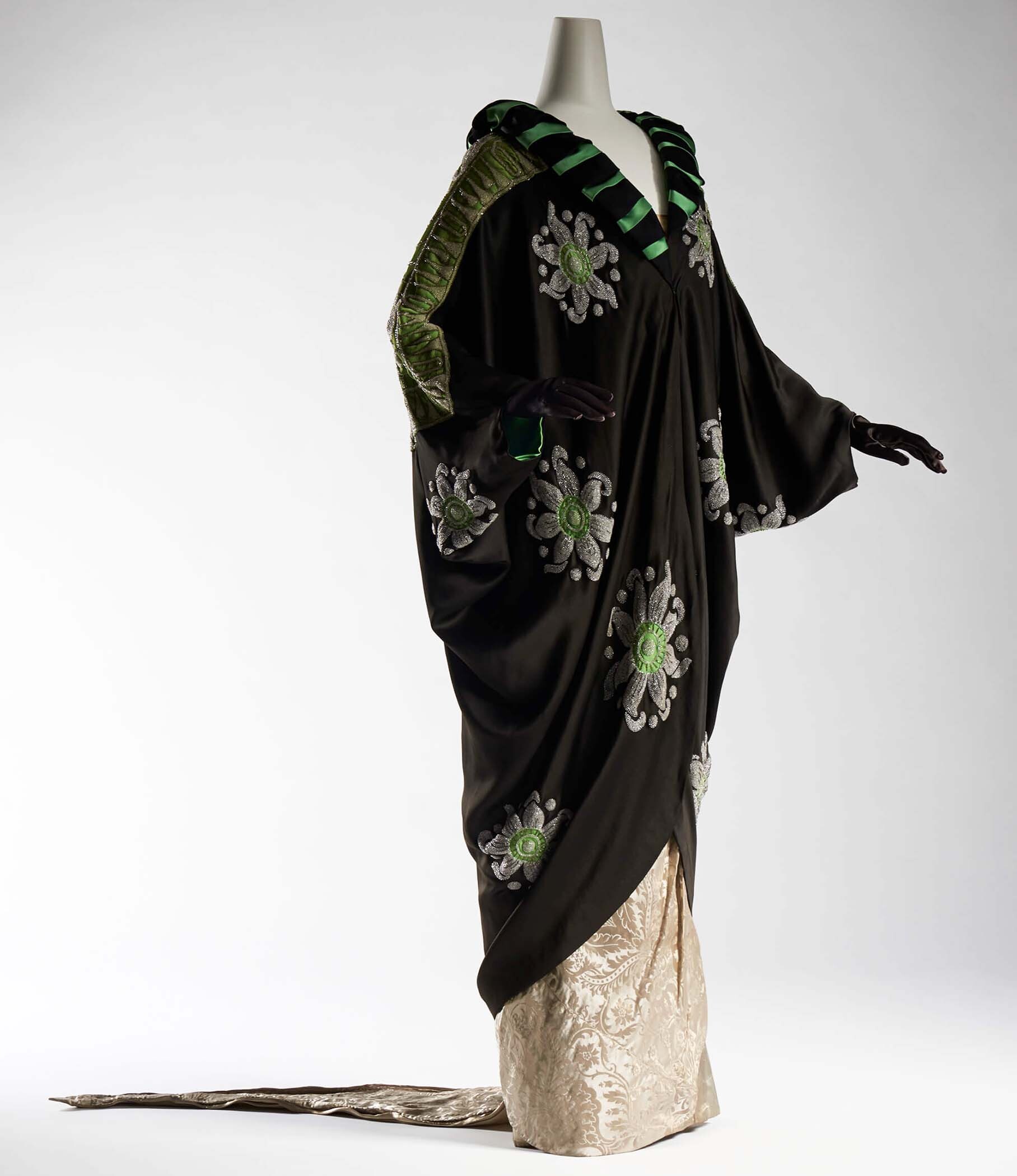 © The Kyoto Costume Institute, photo by Masayuki Hayashi
© The Kyoto Costume Institute, photo by Masayuki Hayashi
Evening Coatc. 1913
A coat with a silhouette like an outer robe for kimono was described as a “manteau japonais” by fashion magazines of the time, and the silhouette of this particular coat is reminiscent of the “uchikake” robe worn by kabuki actors or oiran courtesans in ukiyoe prints. The boldly striped collar is probably inspired by the “date-eri” collar style used in kabuki costume. The flower-like motifs executed in embroidered beads look like the traditional “hanakatsumi” motif that became popular in late Edo-period Japan when favored by kabuki actors. In contrast, the motifs on the bordered panel on the back resemble motifs used around the Mediterranean in ancient times, and could reasonably be called palmettes. This coat is an excellent example of oriental-style wear packed with eclectic elements that was fashionable early in the 1910s. Maison Amy Linker opened in Paris in 1900, specializing particularly in coats and suits. Its latest products were frequently seen in French fashion magazines early in the 20th century. The house is perhaps best known for introducing sporty fashions in the 1920s.
DesignerAmy Linker
BrandAmy Linker
LabelAMY LINKER LINKER & Co. Sps. 7 RUE AUBER PARIS
MaterialBlack silk satin and light green silk crêpe; bead embroidery of floral or oriental motif; black and green silk satin collar.
Inventory Number(s)AC3775 81-8-1
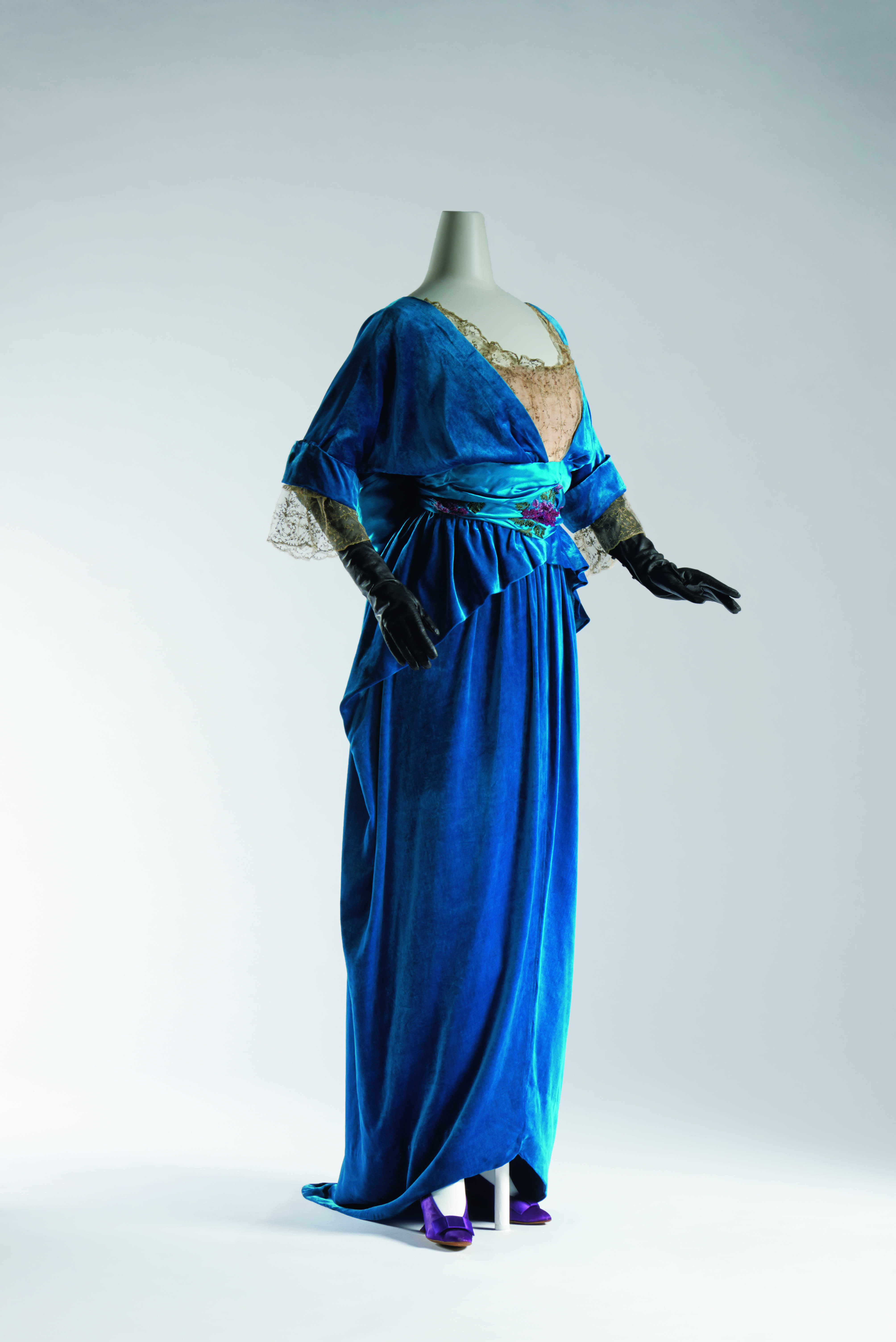 © ©The Kyoto Costume Institute, photo by Masayuki Hayashi
© ©The Kyoto Costume Institute, photo by Masayuki Hayashi
Evening DressGeorges Dœuillet, c. 1913
Evening dress with kimono sleeves and a sash belt sewn to the body that looks liks a heko-obi, a soft informal kimono sash. The elements seen in this dress clearly demonstrate the trend for kimono-style dress that began in emerge in about 1907. Around 1913, in particular, sash belts like this frequently appeared in women’s magazines.
French designer Georges Dœuillet (1865-1934) opened his own haute couture maison in Place Vendome in 1900 after working as business manager for Callot Sœurs. His early designs were highly decorative and elegant, in line with the fashions of that time, but from about 1909, he produced pieces with simpler lines, adapting the flexible garments of the Athenians to suit contemporary styles, as noted in La Ville Lumière: Anecdotes et Documents (Paris, 1909, p.77). This quick response to the new fashion led by Paul Poiret bears witness to Dœuillet’s agility.
DesignerGeorges Dœuillet
BrandDœuillet
LabelDœuillet 18 PLACE VENDOME PARIS
MaterialBlue velvet one-piece dress; blue silk satin sash in obi style; kimono sleeves; white silk lace at neck and cuffs
Inventory Number(s)AC9313 96-8-1
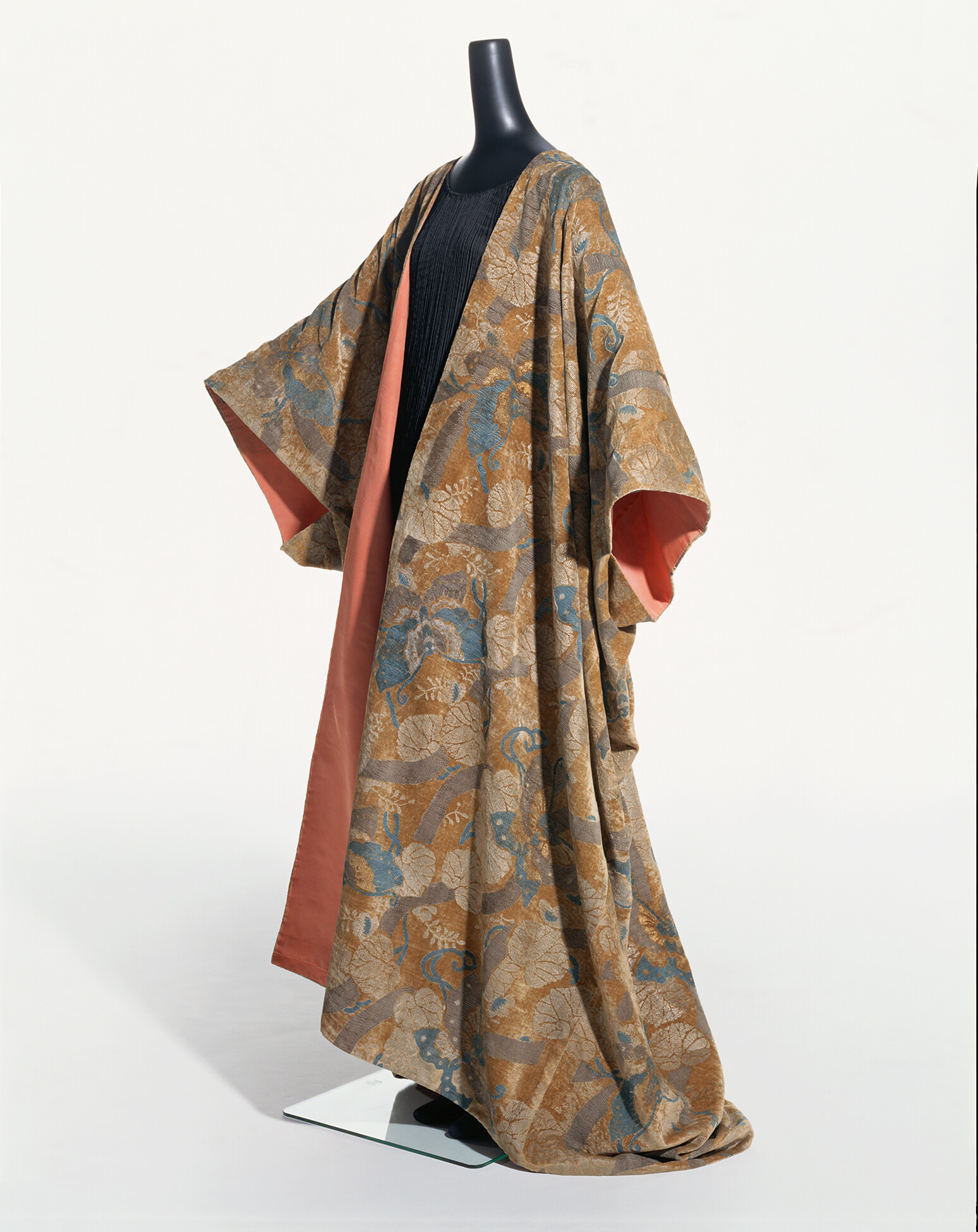 © ©The Kyoto Costume Institute, photo by Kazumi Kurigami
© ©The Kyoto Costume Institute, photo by Kazumi Kurigami
Kimono CoatMariano Fortuny, 1910s
A gorgeous informal, indoor wear. The "tatewaku" (hourglass line) pattern with butterfly and hollyhock motifs was inspired by a Japanese fabric. Mariano Fortuny sought out pattern design sources from diverse periods and regions, including Japan. The textile for this coat has the almost same design as that of Japanese cut silk velvet for kimono sashes. This Japanese textile was described by the journal "Le Japon artistique" (vol. 2, 1888) and later by "Étoffes Japonaises" (1910) (At present, the original sash textile is housed in Les arts decoratifs, Paris.) For this coat, the pattern is produced by stencil printing.
At the end of the 19th century Western people began to wear Japanese kimonos, which are loose-fitting and liberating, as undress. Kimono-style indoor wear and coats were produced in both Europe and the U.S.
DesignerMariano Fortuny
BrandFortuny
Labelnone
MaterialLight brown velvet with polychrome stencil print of Japanese traditional pattern; salmon-pink silk faille lining; straight-cut structure.
Inventory Number(s)AC7771 93-19
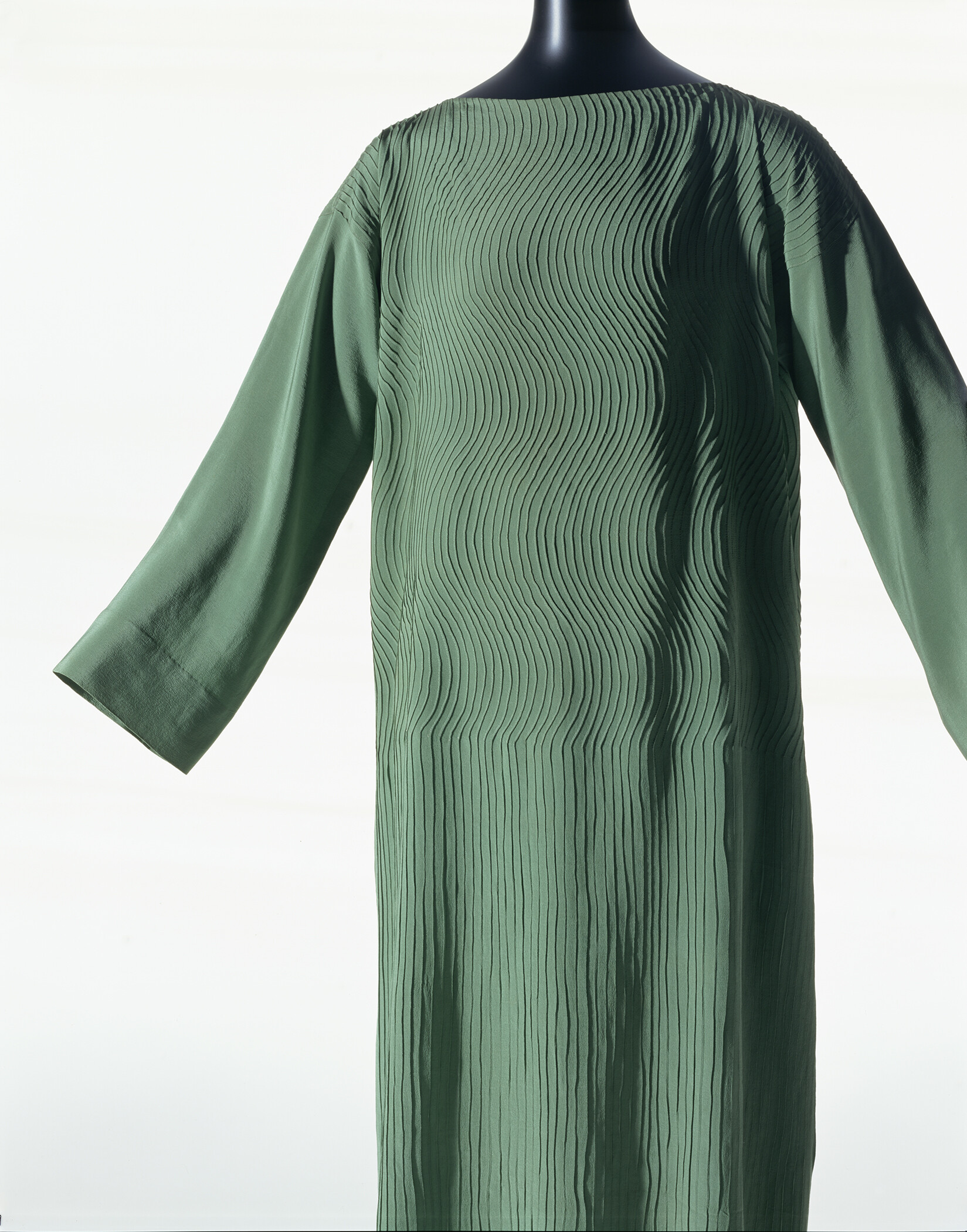 © ©The Kyoto Costume Institute, photo by Kazumi Kurigami
© ©The Kyoto Costume Institute, photo by Kazumi Kurigami
Day DressMadeleine Vionnet, 1924
Pin-tucks were hand-stitched all over the dress. At first glance it looks simple, but it was realized by exquisite handwork only found in Haute Couture, which is impossible to realize today. In this dress pin-tucks are used both for decoration and for a functional purpose. We can glimpse here the essence of dress making by Madeleine Vionnet, who said "Being simple encompasses all complex factors." From an early stage, Vionnet aimed to liberate bodies, and inspired by the straight form of Japanese kimonos, started to create dresses focusing on kimonos' structures in the late 1910s. Eventually she established a new structural concept for clothing that reinterpreted and highlighted the beauty of the female body. This day dress is one of Vionnet's landmark works, marking the peak of her achievements in the 1920s.
DesignerMadeleine Vionnet
BrandMadeleine Vionnet
LabelMadeleine Vionnet
MaterialGreen silk crepe; straight silhouette; boat neck; all-over wavy pattern in pin-tucks.
Inventory Number(s)AC8947 93-32-5

